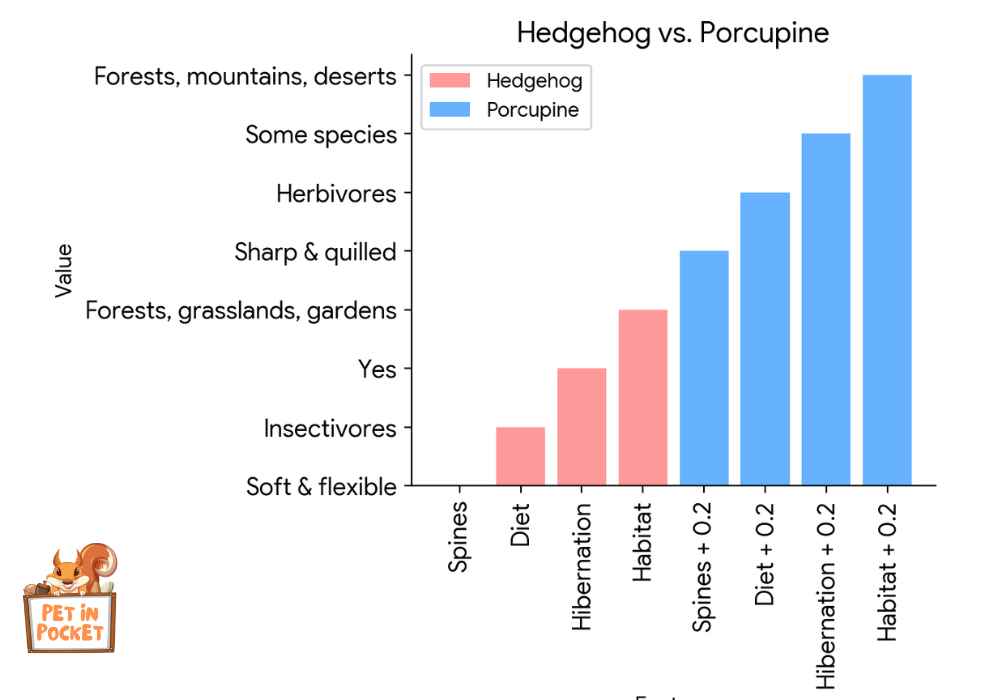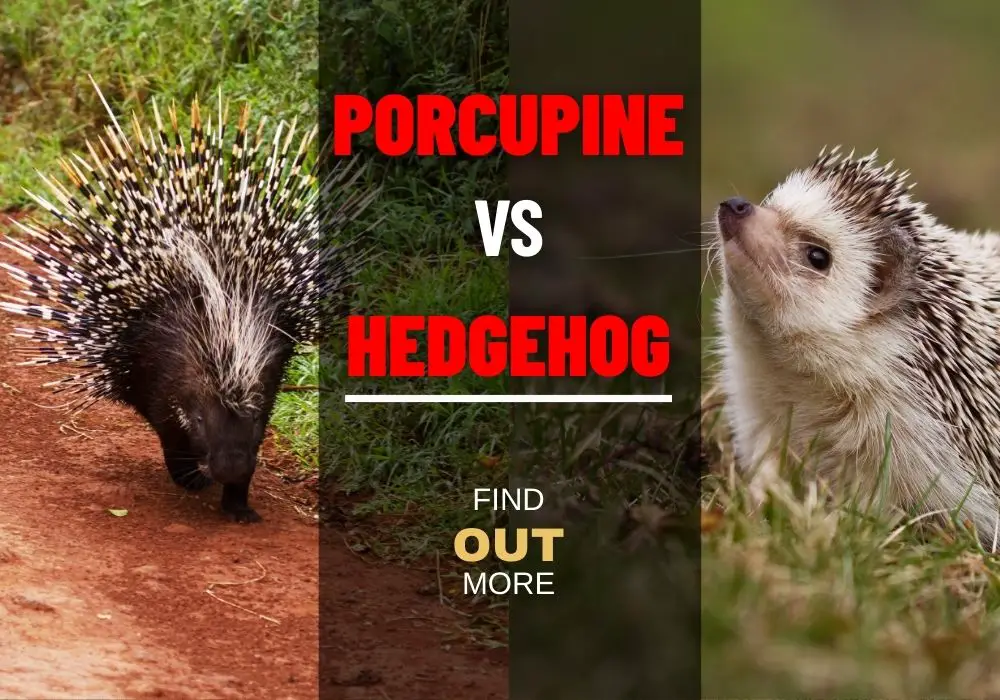What’s the difference between a porcupine and a hedgehog? Although porcupines and hedgehogs have distinctive quills, they vary in size, defense methods, food, and where they live. Their fur is rough and bristly, and they use sharp, spiky quills for defense.
Porcupines are bigger, about 12 to 35 inches long. They live in woods, wooded areas, and hilly places in the Americas, Europe, and some parts of Asia. They eat mostly bark, leaves, and plants. Hedgehogs are smaller, 4-12 inches long, and have softer, spiky quills that can’t be removed. To protect themselves, they curl up into a ball. They eat various things, like plants, insects, and small animals. They can live in parks, cities, and other European, Asian, and African places. These differences show how these two interesting species have different ways of staying alive. Let’s explore more with us!
Table of Contents
Hedgehog vs. Porcupine
| Feature | Hedgehog | Porcupine |
|---|---|---|
| Size | Small (4-12 inches in length) | Larger (12-35 inches in length) |
| Weight | Lighter (5 oz to 2.5 lbs) | Heavier (2.5 to 77 lbs) |
| Quills | Short, dense, and not easily detached | Long, sharp, and easily detachable |
| Habitat | Europe, Asia, and Africa | North and South America, Europe, and Asia |
| Diet | Mostly insects, some plants and small animals | Mainly plants, tree bark, and sometimes small animals |
| Social Behavior | Solitary, except during mating season | Mostly solitary, some species are social |
| Defense Mechanism | Rolls into a ball to protect vulnerable areas | Releases quills when threatened |
| Lifespan | 3-7 years in the wild | 5-7 years in the wild, up to 15 in captivity |
| Activity | Nocturnal | Mostly nocturnal |
| Climbing Ability | Limited | Good, especially tree-dwelling species |
Size
It’s interesting to see how the sizes of hedgehogs and porcupines compare since they both have spiky skin but are relatively small.
The smallest of the two is the hedgehog. A hedgehog’s length ranges from 4 to 12 inches on average. They can easily fit in your hand since they are minor. They are around the size of a huge apple or a small melon. Additionally, they are lightweight, usually weighing between one and two pounds. A tiny bag of sugar has about the same weight as a hedgehog.

Conversely, porcupines are far more significant. Depending on the species, they may vary widely in size, but generally, their length ranges from 12 to 35 inches, or around the length of a regular yardstick or slightly longer. Additionally, they weigh a lot more—some species may weigh up to 20 pounds. It’s similar to toting a medium-sized dog!
Therefore, see a hedgehog as a little, hand-sized animal and a porcupine as a large, prickly bundle that might easily occupy a considerable chunk of your lap when you imagine the two animals side by side.
Weight
As you can see, these two are very different, even though people often mix them up because of their spiky sides.
We start with hedgehogs. These little creatures are well-known for their cute appearance and diminutive stature. A hedgehog’s typical weight ranges from 400 to 700 grams. That almost equals the weight of a tiny pineapple. Due to their low weight, hedgehogs may easily fit into a person’s palm.
Let’s go on to the porcupines now. When compared to hedgehogs, these creatures are undoubtedly heavier. A porcupine’s average weight ranges from 5 to 16 kg. That’s about the weight of a medium-sized dog, to put things into perspective! Porcupines are more prominent, heavier, and have longer, sharper quills than hedgehogs.
There is a significant difference between the two. Porcupines are big, lumbering animals you’d encounter in the woods and, indeed, not anything you’d want to pick up! Hedgehogs are these little, palm-sized critters you may discover scuttling about your yard! Even though they are both protected by spikes, their weight differences bring forth their unique characteristics. Isn’t nature amazing?
Quills

The small, smooth quills of hedgehogs are securely linked to their bodies and are mainly utilized for protection by balling up into a ball. In contrast, porcupine quills are longer, more angular, and may be detached; they are designed to cling to predators. Porcupine and hedgehog quills vary in stiffness and sharpness, indicating their various defensive mechanisms and environmental adaptations. Hedgehog quills are softer and more flexible.
Habitat
Hedgehogs and porcupines, though both spiny, differ significantly in their habitats. Hedgehogs favor gardens, woodlands, and meadows in Europe, Asia, and Africa, thriving in environments with hiding spots and rich insect food sources. Porcupines across North and South America and parts of Asia and Africa adapt to a broader range of habitats, including forests, deserts, and rocky areas. They are adept climbers, often dwelling in trees or rocky outcrops, in contrast to the more ground-oriented, secretive hedgehogs.
Diet
What hedgehogs and porcupines eat is very different. Hedgehogs eat primarily insects and worms, but they also sometimes eat small animals and bird eggs. Plus, they can eat plants and fruits. Their varied food helps them survive in various places, even cities.
Porcupines, on the other hand, eat plants. They eat plants, mostly leaves, sticks, bark, and sometimes fruits and berries. This food is essential for keeping their teeth healthy as their teeth grow.
Social Behavior
Hedgehogs usually stay alone and only come into contact with other hedgehogs during breeding. Besides this, they live and hunt on their own. Porcupines, on the other hand, are a little more friendly. Porcupines are tolerant of each other and may share areas and dens with other porcupines, especially when it is cold outside. The hedgehog and the porcupine both use their quills for defense, but they are not social animals in the same way. Hedgehogs usually live alone, while porcupines can live with other animals, especially in challenging conditions.
Defense Mechanism
Both hedgehogs and porcupines use spikes for defense but in different ways. Hedgehogs roll into a ball to keep enemies away and make their spines stick out. These spines are tough hairs that can’t be pulled off. On the other hand, porcupines’ quills are longer and more complex, and they can break off and stick into enemies. Porcupines also use a quill-rattling show to scare off predators. As you can see, hedgehogs use their spiked fur as passive defense, while porcupines are more active and give enemies a painful warning to stay away.
Lifespan
Both hedgehogs and porcupines have sharp spines, but their lives are very different, especially regarding how long they stay around. Hedgehogs are cute little animals that you can often find in parks. They usually live for three to seven years. This can last longer in captivity, where they are safe from threats and get regular care.
Porcupines, on the other hand, are more like the wise old animals. In captivity, they’ve been known to live up to 15 years, much longer than in the wild, where they only live 5 to 7 years. This is partly because they live longer. After all, they are bigger and don’t have as many natural enemies as hedgehogs do.
Activity

Hedgehogs are nocturnal, which means they hunt for food at night and rest during the day. Porcupines, especially those from the Old World, also spend most of their night looking for plants to eat. The night is when both animals eat and stay away from animals that could hurt them.
Climbing Ability
It’s interesting to look at how to compare hedgehogs‘ and porcupines‘ climbing skills. First, let’s talk about hedgehogs. These cute animals are known for having spiky bodies and cute personalities. In terms of their ability to climb, hedgehogs are good. They can get over things like rocks and small logs but could improve. Because they are fat and have short legs, they can’t climb trees or high slopes.
On the other hand, porcupines, especially the North American porcupines, can climb very well. The long claws and strong grips with spikes on these animals make them good at climbing trees. They do it all the time. They climb trees to get food like leaves and bark and away from animals that could hurt them. It has been seen that porcupines can easily climb and descend trees, and they spend a lot of time in the branches.
Conclusion
In conclusion, hedgehogs and porcupines have some things in common, like having quills. But they are very different in terms of size, environment, food, and how they interact with each other. Insect-eating hedgehogs are tiny and mostly live in the Old World. Porcupines, on the other hand, are more extensive and mostly eat plants. They can be found in the New and Old Worlds, and their group behavior varies. These cute differences are what make each animal unique and exciting on its own.
FAQ
Are porcupines and hedgehogs endangered?
The conservation status of these animals varies by species. Some species of porcupines and hedgehogs are considered endangered due to habitat loss and other factors.
How do porcupines and hedgehogs handle cold weather?
Some species of hedgehogs hibernate during cold weather, whereas porcupines do not hibernate but may stay in their dens during icy conditions.
Can porcupines and hedgehogs be kept as pets?
Hedgehogs are commonly kept as pets, especially in Europe and North America. Having larger and detachable quills, porcupines are less widely kept as pets and require specialized care.
How do porcupines and hedgehogs reproduce?
Both species have similar breeding habits, but porcupines tend to have a more extended gestation period than hedgehogs. The young of both species are born with soft quills or spines, which harden after birth.
How do porcupines and hedgehogs communicate?
Porcupines communicate through a variety of sounds, including grunts, screams, and whines, and also use body language. Hedgehogs are quieter but will hiss, grunt, or snuffle, especially when threatened.






Leave a Reply